Novel Role for Tranilast in Regulating NLRP3 Ubiquitination, Vascular Inflammation, and Atherosclerosis
- PMID: 32476536
- PMCID: PMC7429049
- DOI: 10.1161/JAHA.119.015513
Novel Role for Tranilast in Regulating NLRP3 Ubiquitination, Vascular Inflammation, and Atherosclerosis
Abstract
Background Aberrant activation of the NLRP3 (nucleotide-binding oligomerization domain, leucine-rich repeat-containing receptor family pyrin domain-containing 3) inflammasome is thought to play a causative role in atherosclerosis. NLRP3 is kept in an inactive ubiquitinated state to avoid unwanted NLRP3 inflammasome activation. This study aimed to test the hypothesis that pharmacologic manipulating of NLRP3 ubiquitination blunts the assembly and activation of the NLRP3 inflammasome and protects against vascular inflammation and atherosclerosis. Since genetic studies yielded mixed results about the role for this inflammasome in atherosclerosis in low-density lipoprotein receptor- or apolipoprotein E-deficient mice, this study attempted to clarify the discrepancy with the pharmacologic approach using both models. Methods and Results We provided the first evidence demonstrating that tranilast facilitates NLRP3 ubiquitination. We showed that tranilast restricted NLRP3 oligomerization and inhibited NLRP3 inflammasome assembly. Tranilast markedly suppressed NLRP3 inflammasome activation in low-density lipoprotein receptor- and apolipoprotein E-deficient macrophages. Through reconstitution of the NLRP3 inflammasome in human embryonic kidney 293T cells, we found that tranilast directly limited NLRP3 inflammasome activation. By adopting different regimens for tranilast treatment of low-density lipoprotein receptor- and apolipoprotein E-deficient mice, we demonstrated that tranilast blunted the initiation and progression of atherosclerosis. Mice receiving tranilast displayed a significant reduction in atherosclerotic lesion size, concomitant with a pronounced decline in macrophage content and expression of inflammatory molecules in the plaques compared with the control group. Moreover, tranilast treatment of mice substantially hindered the expression and activation of the NLRP3 inflammasome in the atherosclerotic lesions. Conclusions Tranilast potently enhances NLRP3 ubiquitination, blunts the assembly and activation of the NLRP3 inflammasome, and ameliorates vascular inflammation and atherosclerosis in both low-density lipoprotein receptor- and apolipoprotein E-deficient mice.
Keywords: NLRP3 ubiquitination; atherosclerosis; inflammasome; tranilast; vascular inflammation.
Figures


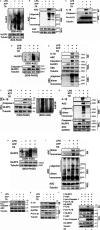
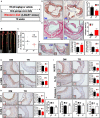
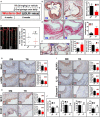
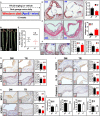
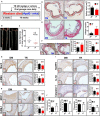
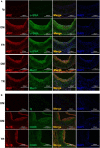
Similar articles
-
Tanshinone IIA attenuates atherosclerosis via inhibiting NLRP3 inflammasome activation.Aging (Albany NY). 2020 Nov 16;13(1):910-932. doi: 10.18632/aging.202202. Epub 2020 Nov 16. Aging (Albany NY). 2020. PMID: 33290264 Free PMC article.
-
Deficient Chaperone-Mediated Autophagy Promotes Inflammation and Atherosclerosis.Circ Res. 2021 Dec 3;129(12):1141-1157. doi: 10.1161/CIRCRESAHA.121.318908. Epub 2021 Oct 27. Circ Res. 2021. PMID: 34704457 Free PMC article.
-
Cholesterol Efflux Pathways Suppress Inflammasome Activation, NETosis, and Atherogenesis.Circulation. 2018 Aug 28;138(9):898-912. doi: 10.1161/CIRCULATIONAHA.117.032636. Circulation. 2018. PMID: 29588315 Free PMC article.
-
The NLRP3 inflammasome and the emerging role of colchicine to inhibit atherosclerosis-associated inflammation.Atherosclerosis. 2018 Feb;269:262-271. doi: 10.1016/j.atherosclerosis.2017.12.027. Epub 2017 Dec 25. Atherosclerosis. 2018. PMID: 29352570 Review.
-
NLRP3 Inflammasome and the IL-1 Pathway in Atherosclerosis.Circ Res. 2018 Jun 8;122(12):1722-1740. doi: 10.1161/CIRCRESAHA.118.311362. Circ Res. 2018. PMID: 29880500 Review.
Cited by
-
NLRP3 inflammasome in endothelial dysfunction.Cell Death Dis. 2020 Sep 18;11(9):776. doi: 10.1038/s41419-020-02985-x. Cell Death Dis. 2020. PMID: 32948742 Free PMC article. Review.
-
Tranilast reduces cardiomyocyte injury induced by ischemia‑reperfusion via Nrf2/HO‑1/NF‑κB signaling.Exp Ther Med. 2023 Feb 22;25(4):160. doi: 10.3892/etm.2023.11859. eCollection 2023 Apr. Exp Ther Med. 2023. PMID: 36911371 Free PMC article.
-
Spotlight on NLRP3 Inflammasome: Role in Pathogenesis and Therapies of Atherosclerosis.J Inflamm Res. 2021 Dec 21;14:7143-7172. doi: 10.2147/JIR.S344730. eCollection 2021. J Inflamm Res. 2021. PMID: 34992411 Free PMC article. Review.
-
Bridging inflammation and venous thrombosis: the NLRP3 inflammasome connection.Front Cardiovasc Med. 2025 May 30;12:1584745. doi: 10.3389/fcvm.2025.1584745. eCollection 2025. Front Cardiovasc Med. 2025. PMID: 40520933 Free PMC article. Review.
-
Treatment mechanism of immune triad from the repurposing drug against COVID-19.Transl Med Aging. 2023;7:33-45. doi: 10.1016/j.tma.2023.06.005. Epub 2023 Jun 24. Transl Med Aging. 2023. PMID: 37388715 Free PMC article. Review.
References
-
- Ridker PM, Everett BM, Thuren T, MacFadyen JG, Chang WH, Ballantyne C, Fonseca F, Nicolau J, Koenig W, Anker SD, et al. Antiinflammatory therapy with canakinumab for atherosclerotic disease. N Engl J Med. 2017;377:1119–1131. - PubMed
-
- Voronov E, Apte RN. Targeting the tumor microenvironment by intervention in interleukin‐1 biology. Curr Pharm Des. 2017;23:4893–4905. - PubMed
Publication types
MeSH terms
Substances
LinkOut - more resources
Full Text Sources
Medical

